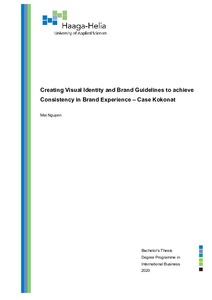Creating Visual Identity and Brand Guidelines to achieve Consistency in Brand Experience – Case Kokonat
Nguyen, Mai (2020)
Nguyen, Mai
2020
All rights reserved. This publication is copyrighted. You may download, display and print it for Your own personal use. Commercial use is prohibited.
Julkaisun pysyvä osoite on
https://urn.fi/URN:NBN:fi:amk-2020051812145
https://urn.fi/URN:NBN:fi:amk-2020051812145
Tiivistelmä
Many marketers acknowledge the importance of building and managing a brand. However, the process of creating a visual brand identity tends to be overlooked. In many cases, the visual identity is solely associated with the company logo, when it is in fact a visual presentation of the corporate identity. Visual identity plays a crucial role in differentiating the business from competitors in a highly saturated market, increasing perceived product values, creating brand awareness and communicating a brand story among customers. When implemented properly, visual identity can make a substantial impact on brand consistency, which eventually leads to business growth and customer loyalty.
In this thesis, the author investigates the need for having a visual identity and the process of forming a successful one. The study was carried out through a literature review, which serves as the main foundation to design a visual identity for the case company, Kokonat. Additionally, qualitative research was conducted with Kokonat’s founders in order to gain insights into the company background and customers’ needs and expectations. This provides tremendous support in creating a visual identity which can successfully communicate the brand values and brand story to the targeted audience.
Based on the derived insights from the literature review and qualitative research, an appealing and professional visual identity that corresponds to the brand values was created for the case company. To ensure that the visual identity is coherent and consistent, brand guidelines were developed to support the author in designing customer touchpoints, including a website, presentation template and business card. As visual identity and brand associations are created with a unified look and feel, brand consistency would be maintained, which was the ultimate objective of this project-based thesis.
As the brand story and brand tone of voice were listed outside the scope of this thesis, it is recommended that the commissioning company should continue to develop and incorporate these details into the current brand guidelines, which were mainly focused on the visual identity aspect. More importantly, the case company should always keep the brand guidelines up-to-date, as well as inform its employees to closely follow the guidelines to maintain the consistency of the visual identity, and eventually the brand experience.
In this thesis, the author investigates the need for having a visual identity and the process of forming a successful one. The study was carried out through a literature review, which serves as the main foundation to design a visual identity for the case company, Kokonat. Additionally, qualitative research was conducted with Kokonat’s founders in order to gain insights into the company background and customers’ needs and expectations. This provides tremendous support in creating a visual identity which can successfully communicate the brand values and brand story to the targeted audience.
Based on the derived insights from the literature review and qualitative research, an appealing and professional visual identity that corresponds to the brand values was created for the case company. To ensure that the visual identity is coherent and consistent, brand guidelines were developed to support the author in designing customer touchpoints, including a website, presentation template and business card. As visual identity and brand associations are created with a unified look and feel, brand consistency would be maintained, which was the ultimate objective of this project-based thesis.
As the brand story and brand tone of voice were listed outside the scope of this thesis, it is recommended that the commissioning company should continue to develop and incorporate these details into the current brand guidelines, which were mainly focused on the visual identity aspect. More importantly, the case company should always keep the brand guidelines up-to-date, as well as inform its employees to closely follow the guidelines to maintain the consistency of the visual identity, and eventually the brand experience.
